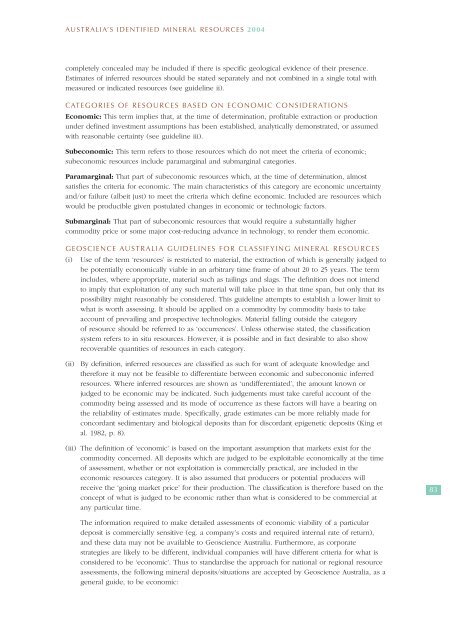australia's identified mineral resources 2004 - Geoscience Australia
australia's identified mineral resources 2004 - Geoscience Australia
australia's identified mineral resources 2004 - Geoscience Australia
Create successful ePaper yourself
Turn your PDF publications into a flip-book with our unique Google optimized e-Paper software.
AUSTRALIA’S IDENTIFIED MINERAL RESOURCES <strong>2004</strong><br />
completely concealed may be included if there is specific geological evidence of their presence.<br />
Estimates of inferred <strong>resources</strong> should be stated separately and not combined in a single total with<br />
measured or indicated <strong>resources</strong> (see guideline ii).<br />
CATEGORIES OF RESOURCES BASED ON ECONOMIC CONSIDERATIONS<br />
Economic: This term implies that, at the time of determination, profitable extraction or production<br />
under defined investment assumptions has been established, analytically demonstrated, or assumed<br />
with reasonable certainty (see guideline iii).<br />
Subeconomic: This term refers to those <strong>resources</strong> which do not meet the criteria of economic;<br />
subeconomic <strong>resources</strong> include paramarginal and submarginal categories.<br />
Paramarginal: That part of subeconomic <strong>resources</strong> which, at the time of determination, almost<br />
satisfies the criteria for economic. The main characteristics of this category are economic uncertainty<br />
and/or failure (albeit just) to meet the criteria which define economic. Included are <strong>resources</strong> which<br />
would be producible given postulated changes in economic or technologic factors.<br />
Submarginal: That part of subeconomic <strong>resources</strong> that would require a substantially higher<br />
commodity price or some major cost-reducing advance in technology, to render them economic.<br />
GEOSCIENCE AUSTRALIA GUIDELINES FOR CLASSIFYING MINERAL RESOURCES<br />
(i) Use of the term ‘<strong>resources</strong>’ is restricted to material, the extraction of which is generally judged to<br />
be potentially economically viable in an arbitrary time frame of about 20 to 25 years. The term<br />
includes, where appropriate, material such as tailings and slags. The definition does not intend<br />
to imply that exploitation of any such material will take place in that time span, but only that its<br />
possibility might reasonably be considered. This guideline attempts to establish a lower limit to<br />
what is worth assessing. It should be applied on a commodity by commodity basis to take<br />
account of prevailing and prospective technologies. Material falling outside the category<br />
of resource should be referred to as ‘occurrences’. Unless otherwise stated, the classification<br />
system refers to in situ <strong>resources</strong>. However, it is possible and in fact desirable to also show<br />
recoverable quantities of <strong>resources</strong> in each category.<br />
(ii)<br />
By definition, inferred <strong>resources</strong> are classified as such for want of adequate knowledge and<br />
therefore it may not be feasible to differentiate between economic and subeconomic inferred<br />
<strong>resources</strong>. Where inferred <strong>resources</strong> are shown as ‘undifferentiated’, the amount known or<br />
judged to be economic may be indicated. Such judgements must take careful account of the<br />
commodity being assessed and its mode of occurrence as these factors will have a bearing on<br />
the reliability of estimates made. Specifically, grade estimates can be more reliably made for<br />
concordant sedimentary and biological deposits than for discordant epigenetic deposits (King et<br />
al. 1982, p. 8).<br />
(iii) The definition of ‘economic’ is based on the important assumption that markets exist for the<br />
commodity concerned. All deposits which are judged to be exploitable economically at the time<br />
of assessment, whether or not exploitation is commercially practical, are included in the<br />
economic <strong>resources</strong> category. It is also assumed that producers or potential producers will<br />
receive the ‘going market price’ for their production. The classification is therefore based on the<br />
concept of what is judged to be economic rather than what is considered to be commercial at<br />
any particular time.<br />
83<br />
The information required to make detailed assessments of economic viability of a particular<br />
deposit is commercially sensitive (eg. a company’s costs and required internal rate of return),<br />
and these data may not be available to <strong>Geoscience</strong> <strong>Australia</strong>. Furthermore, as corporate<br />
strategies are likely to be different, individual companies will have different criteria for what is<br />
considered to be ‘economic’. Thus to standardise the approach for national or regional resource<br />
assessments, the following <strong>mineral</strong> deposits/situations are accepted by <strong>Geoscience</strong> <strong>Australia</strong>, as a<br />
general guide, to be economic:

















